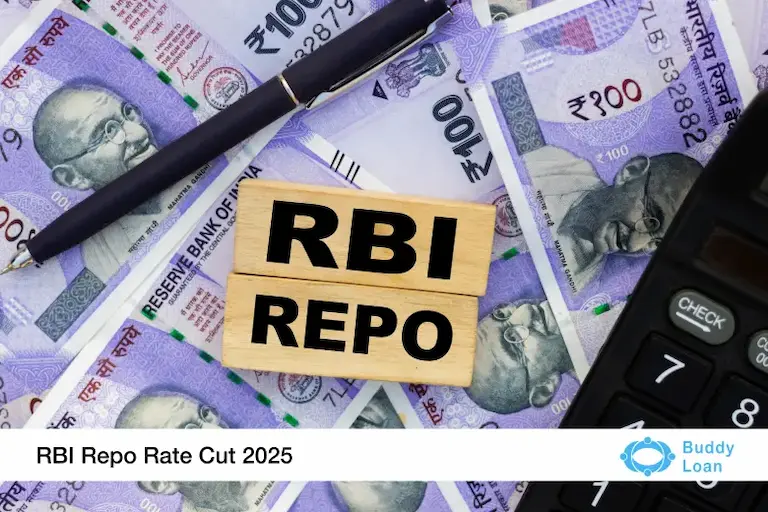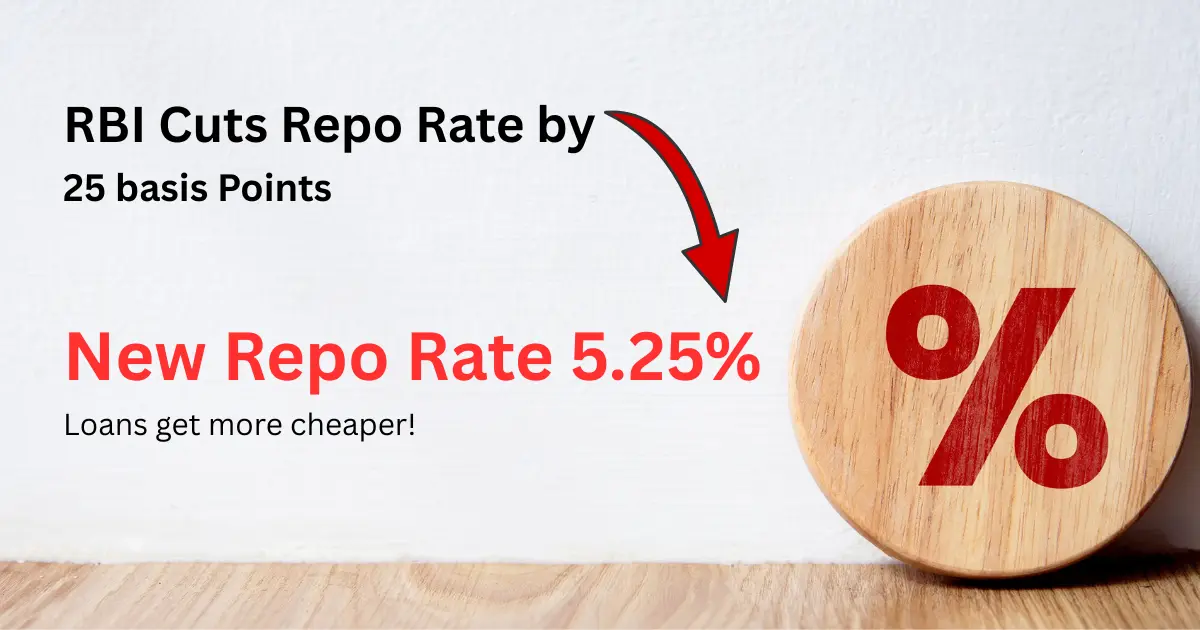The Reserve Bank of India (RBI) surprised borrowers and the economy by cutting the repo rate by 25 basis points to 6.25%. This is the first-rate reduction in nearly five years, raising hopes for cheaper loans, higher consumer spending, and economic growth. Following the Budget 2025 announcement of no tax on income up to ₹12 lakh, this rate cut is expected to further boost domestic activity and consumption. This blog explores the impact of the decision on the economy, personal finance, and its potential consequences.
Latest Update:
|
Repo Rate
The repo rate is the interest rate at which the central bank (RBI in India) lends money to commercial banks. Think of it as the rate at which banks borrow from the RBI. It’s a crucial tool used by the RBI to control inflation and manage the money supply in the economy. A lower repo rate makes it cheaper for banks to borrow money, encouraging them to lend more to consumers and businesses, ultimately stimulating economic activity. Conversely, a higher repo rate makes borrowing more expensive, which can help curb inflation. Essentially, the repo rate acts as a benchmark for other lending rates in the market, influencing everything from home loans to business loans.
0
Bad
Check your Credit Score for Free
Your credit score is updated monthly and gives you insight into your creditworthiness. Take control of your financial future today.
Current Updates on RBI Repo Rate Cut 2025
Here are the key highlights of the RBI’s recent decision.
- Rate Cut: The RBI has reduced the repo rate by 25 bps to 6.25%. This reduction, while seemingly small, has a significant impact on the overall cost of borrowing in the economy.
- Timing: This is the first repo rate cut in almost five years, signaling a potential shift in the RBI’s monetary policy stance, from a focus on inflation control to a more growth-oriented approach.
- Objective: The primary goal is to stimulate economic growth and boost consumption, which has been facing some headwinds due to global uncertainties and domestic factors.
- Context: The decision follows the Budget 2025 announcement of no tax on income up to ₹12 lakh, further amplifying the potential positive impact on consumer spending and disposable income.
Impact of Repo Cut on Home Loan EMIs
The repo rate cut is expected to directly impact home loan EMIs, making them more affordable for borrowers. Lower borrowing costs for banks translate to lower interest rates on home loans, reducing the monthly burden on homeowners. This can be particularly beneficial for first-time homebuyers who are often sensitive to interest rate fluctuations. It can also encourage existing homeowners to refinance their loans at lower rates, saving them money in the long run.
Here’s a simplified example of how a repo rate cut could affect home loan EMIs over 20 years. These are just examples; actual rates may vary based on bank policies, loan terms, and credit scores.
| Bank | Loan Amount (₹) | Existing Interest Rate (%) | Existing EMI (₹) | New Interest Rate (%) | New EMI (₹) | Potential Savings Over 20 Years (₹) |
| Bank A | 50 Lakhs | 9.00 | 44,990 | 8.75 | 44,120 | 2,08,800 |
| Bank B | 75 Lakhs | 9.25 | 69,200 | 9.00 | 68,250 | 3,15,000 |
| Bank C | 1 Crore | 8.75 | 81,800 | 8.50 | 80,900 | 4,20,000 |
Note: It is advisable to check with your respective bank for the latest interest rates and EMI calculations. The savings are calculated assuming a 20-year loan tenure.
Personal Loan
Quick Approval in 24 Hours
💰 No processing fee for first 100 customers | ⚡ Digital KYC in 5 minutes
Impact of Repo Rate Cut on the Indian Economy
Beyond individual borrowers, the repo rate cut has broader implications for the overall economy, which we will explore here.
- Increased Borrowing: Lower interest rates encourage businesses and individuals to borrow more money for investments and consumption, leading to increased economic activity.
- Boost to Investment: Increased borrowing facilitates higher investment in new projects, business expansions, and infrastructure development, creating jobs and stimulating growth.
- Higher Consumer Spending: Cheaper loans make it easier for consumers to purchase big-ticket items like cars and homes, boosting demand for goods and services and driving economic growth.
- Impact on Businesses: Lower interest rates reduce the cost of borrowing for businesses, allowing them to invest in expansion, research and development, and hiring, which can lead to increased productivity and competitiveness.
- Potential Challenges: While a repo rate cut can stimulate growth, it’s important to monitor inflation. If demand increases significantly without a corresponding increase in supply, it can lead to inflationary pressures.
Reasons For Repo Rate Cut
Understanding the rationale behind the RBI’s decision is crucial, and this section delves into the factors influencing it.
- Stimulating Growth: The primary objective is to boost economic activity and drive growth, which may have been slowing down due to various factors like global economic uncertainties and domestic demand conditions.
- Managing Inflation: While keeping inflation within the target range, the RBI aims to support growth. The rate cut suggests that the RBI is confident about managing inflationary pressures and believes that supporting growth is currently a priority.
- Supporting Consumption: The rate cut is expected to encourage consumer spending and boost demand, which are crucial for economic recovery and sustained growth.
- Global Economic Factors: The RBI also considers global economic conditions, such as growth prospects, inflation trends, and interest rate policies in other major economies, while making its decisions. A slowdown in global growth can influence domestic economic activity.
- Domestic Economic Indicators: The RBI analyzes domestic economic indicators such as GDP growth, inflation, industrial production, and credit growth before making monetary policy decisions.
Conclusion
The RBI’s repo rate cut is a key development that could benefit borrowers, businesses, and the economy. It is expected to make loans cheaper, boost consumer spending, and stimulate economic growth. While the long-term impact remains to be seen, this move signals the RBI’s commitment to supporting economic recovery and development. It is crucial for individuals and businesses to leverage this opportunity and make informed financial decisions. However, it’s also important to be aware of potential risks, such as rising inflation, and to plan finances accordingly.
Download Personal Loan App
Get a loan instantly! Best Personal Loan App for your needs!!
Looking for an instant loan? Buddy Loan helps you get an instant loan from the best-verified lenders. Download the Buddy Loan App from the Play Store or App Store and apply for a loan now!
Having any queries? Do reach us at info@buddyloan.com
Frequently Asked Questions
Q. How will the repo rate cut impact my existing loan?
A. Your bank may pass on the benefit of the repo rate cut to you by reducing your loan interest rate, which will lower your EMI or reduce the loan tenure. Contact your bank to understand their specific policy and the timeline for implementation.
Q. When will the new interest rates be effective?
A. Banks usually take a few weeks to implement the new interest rates after the RBI’s announcement. Check with your bank for their specific implementation timeline.
Q. Will the repo rate cut affect all types of loans?
A. The repo rate cut mainly affects floating rate loans. However, banks may adjust fixed interest rates based on market conditions, their cost of funds, and competitive pressures.
Q. How does the repo rate cut affect inflation?
A. Repo rate cut can potentially lead to increased inflation if demand outpaces supply. However, the RBI takes measures to keep inflation within the target range. They monitor various inflation indicators and adjust monetary policy as needed.
Q. What should I do as a borrower?
A. Now is a good time to review your existing loans and explore options for refinancing at lower interest rates. Compare offers from different banks to get the best deal. Also, if you’re planning to take out a loan, now might be a good time to do so.




